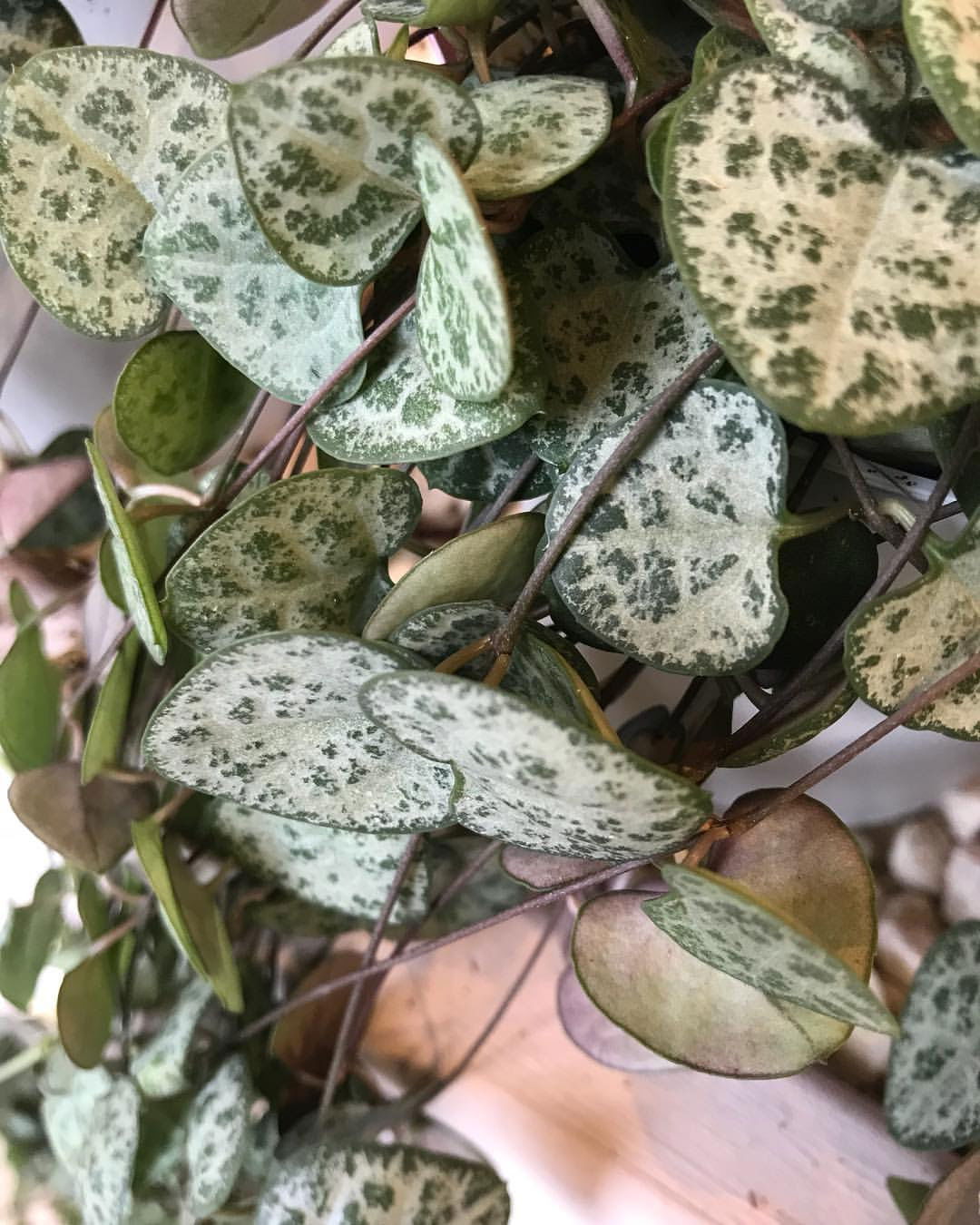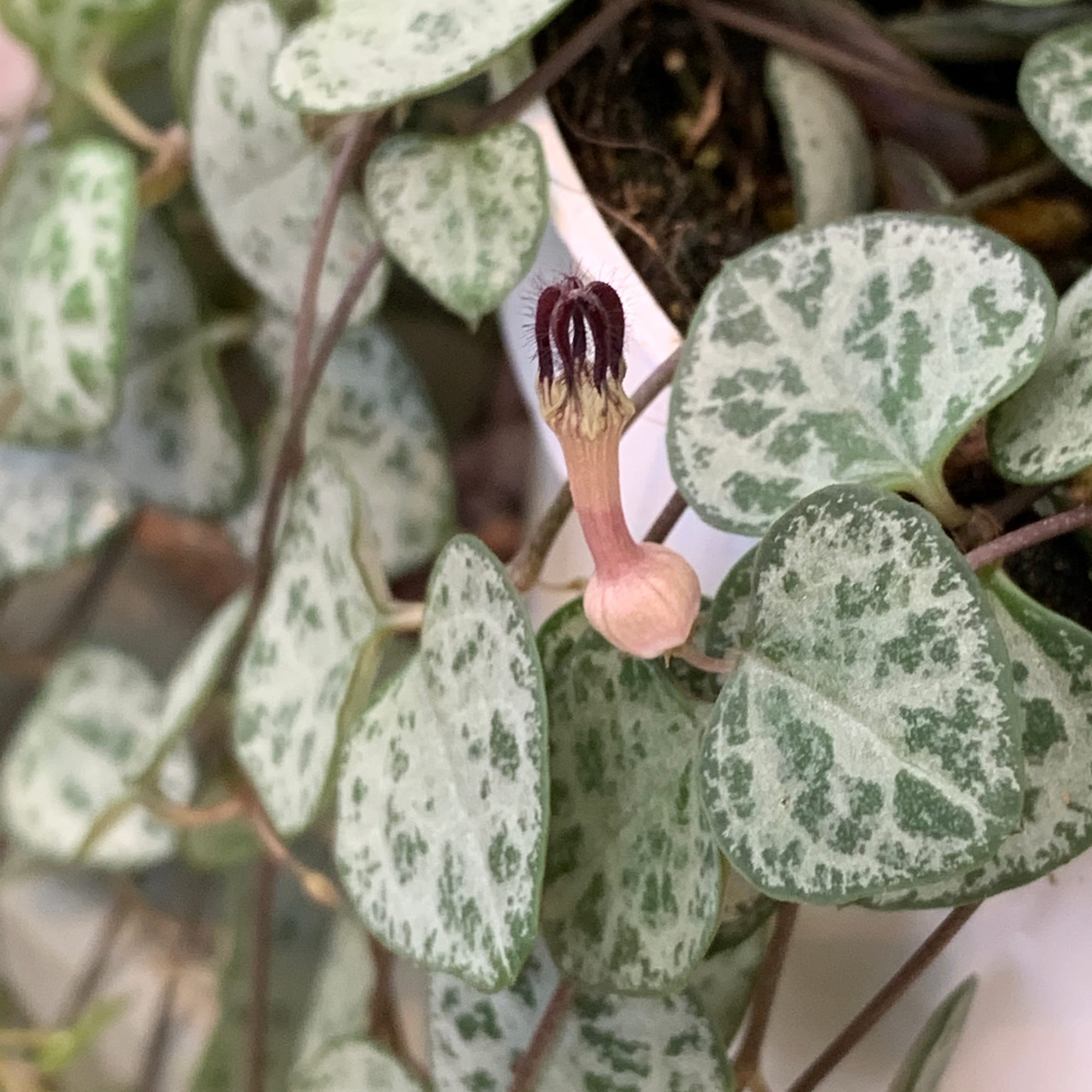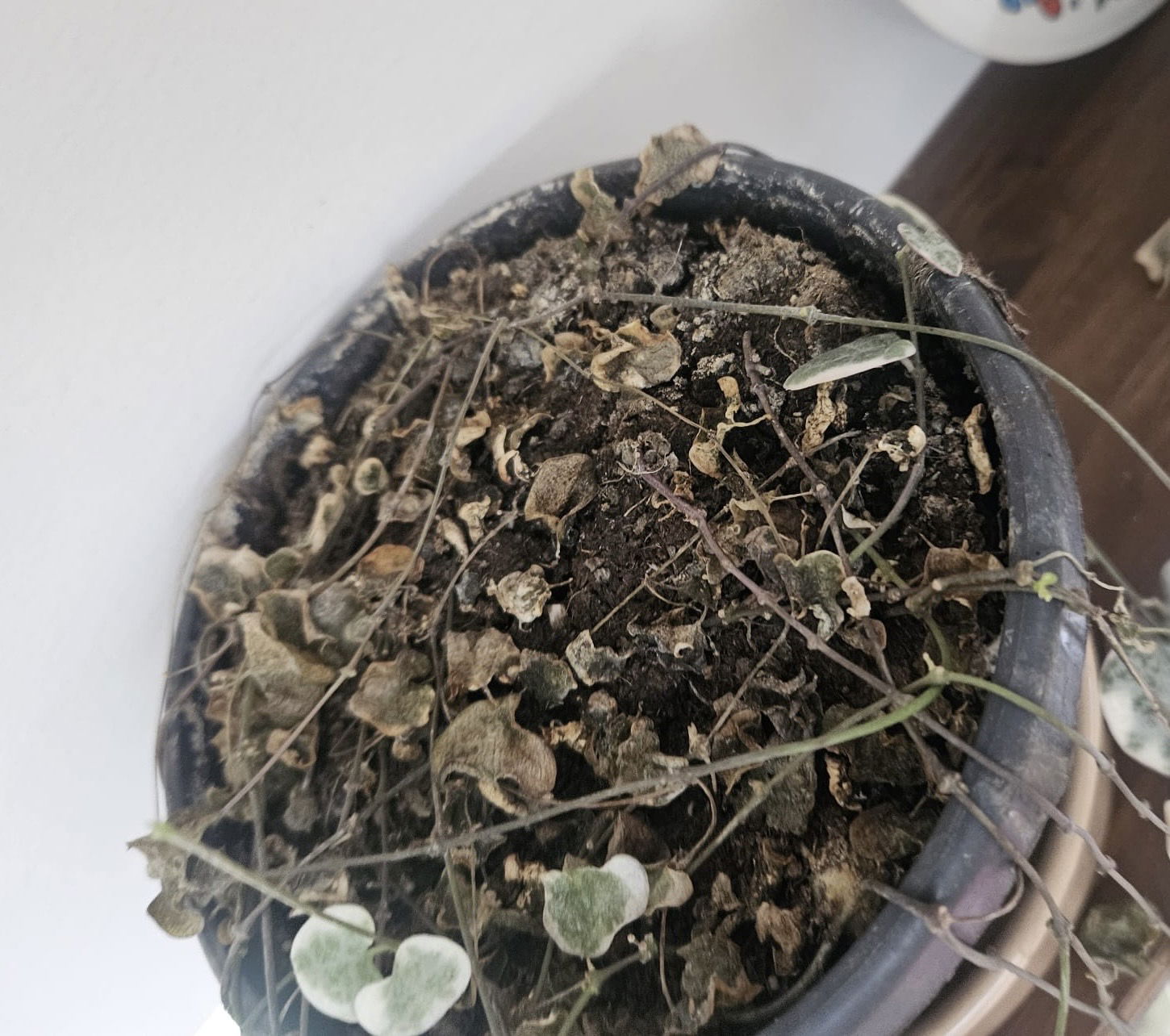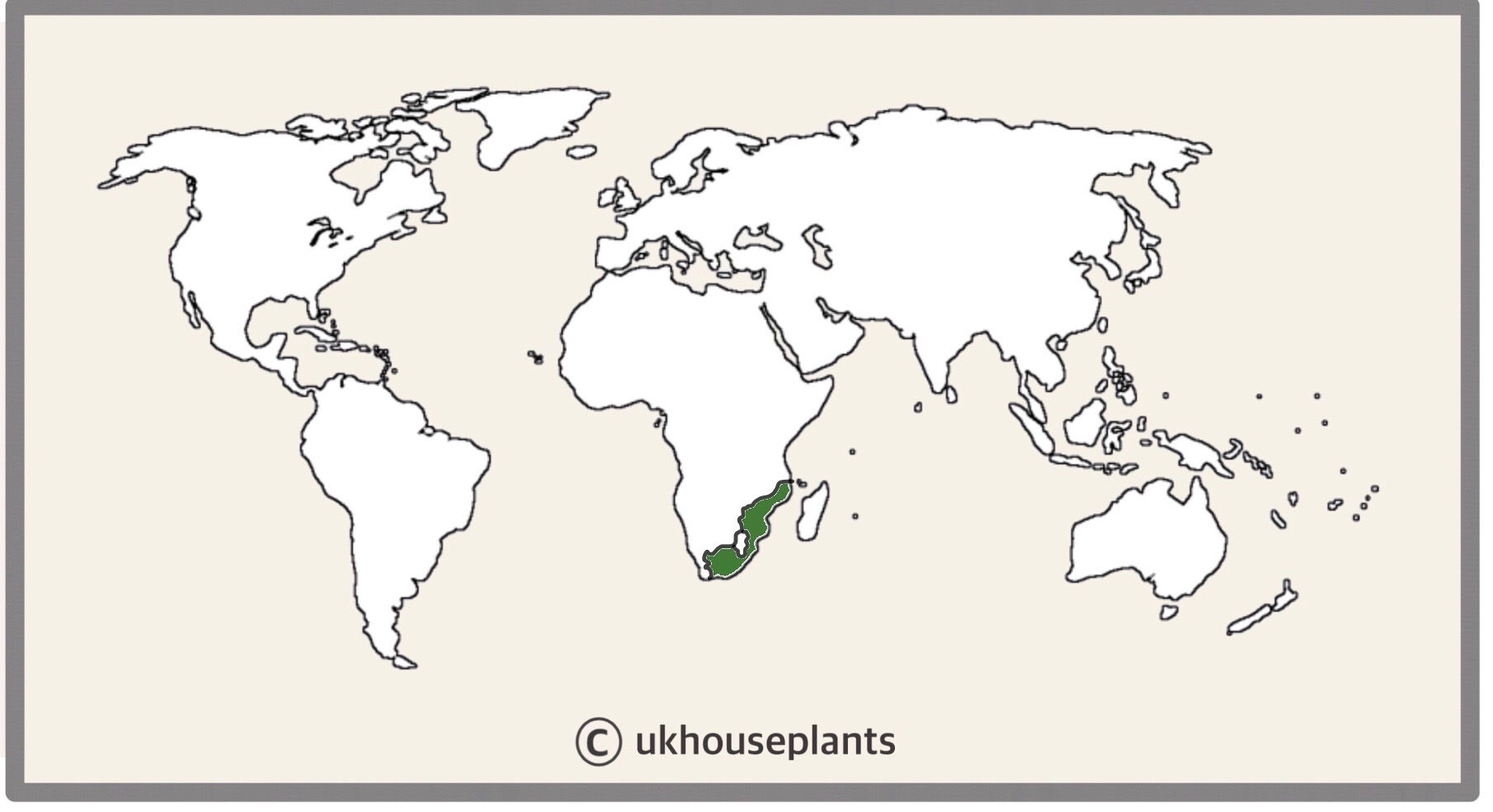
Ceropegia linearis subsp. woodii
Contents
- Top Tips
- Location, Water, Humidity & Fertilisation
- Common Issues
- Origins, Temperature, Propagation, Repotting & Toxicity.
Need the answer to a specific plant query? Book a 1-to-1 video call with THE HOUSEPLANT DOCTOR™, the website's friendly author, to overcome and address your niggling problem! Available on iMessage, WhatsApp, Facebook Messenger & more.
Top Tips & Info
- Care Difficulty - Easy
- Chain of Hearts are best hydrated following the ukhouseplants' phrase of 'Drenches Between Droughts'. Allow ALL of the soil to dry between waters, especially in the autumn and winter when growth slows.
- A few hours of morning or evening sun is mandatory, especially in the winter months. Avoid situating it in a dark location due to the exaggerated phototropism (growth towards light) and leggy internodes.
- Supplement at monthly intervals all year round, using either a 'Cactus & Succulent' or 'Houseplant' labelled fertiliser.
- Repot every three years during the spring, using a 'Cactus & Succulent' potting mix, noting the delicacy of the tubers.
- Take vine cuttings during the spring or summer to put back into the soil to promote a bushier head - head down to 'Propagation' for more information!
Location & Light - 🔸🔸🔸
Although a location that offers bright, indirect light is best, providing a splash of morning sunlight is highly beneficial, especially during the autumn and winter. Darker situations will increase the likelihood of leggy juvenile growth, along with the development of potential root rot. Specimens kept on a shelf where the soil line isn't in view of the natural light will remain moist for longer, which means you must follow the rule of 'drenches between droughts'. Avoid direct sunlight for more than three hours a day due to the exposed risk of sun-scorch.
Water - 🔸
Chain of Hearts must endure drenches between droughts. Either water from the top (albeit carefully), or submerge the bottom quarter of the pot for several minutes in a saucer of water. Excess moisture that rests on the leaves that sit above the soil may result in rot, so it's important to keep this area dry. Under-watering symptoms include crispy or shrivelled leaves, little to no growth and gradual foliage decline. Be sure to study its environment; a position that offers too much sunlight will dry out the soil quickly, eventually leading to sun-scorch and dehydration. Over-watering symptoms include the rapid yellowing of leaves, wilting, mushy leaves/stem, basal rot and plant death. Locations that don't offer enough natural light onto the soil line are more likely to be associated with root rot; scroll down to 'Common Issues' for more information on this!
Humidity -
This isn’t a factor; however, a quick hose down from time to time will wash away dust particles and unwanted pests.
Fertilisation - 🔸
Feed once a month using either a 'Houseplant' or 'Cactus & Succulent' labelled fertiliser. Never apply a 'Ready to Use' product into the soil without a pre-water first, as it may cause root-burn and yellowed leaves.
 The flowers of String of Hearts is generally develop across summer to early winter. Scroll down to 'Flowers' for more information on achieving a bloom!
The flowers of String of Hearts is generally develop across summer to early winter. Scroll down to 'Flowers' for more information on achieving a bloom!
Common Issues with Chain of Hearts
Root rot is a common issue among specimens sat in too dark environments with prolonged soil moisture. Symptoms include rapidly yellowing leaves, mouldy soil, stunted growth and smelly/damp soil (see image below). Take the plant out of the pot and inspect health below the compost line. If the roots sport a yellow tinge, you're good to go, but if they're brown and mushy, action must be taken immediately. More information about addressing root rot can be found on this link.
Small flies hovering around your plant or soil is entirely natural and may just indicate you're watering a little too often. Fungus Gnats are a common 'pest' with Chain of Hearts when over-watered, but won't pose any risk to the plant's health. Simply replace the top quarter of the plant's potting mix for a fresh batch of 'Cactus & Succulent' labelled compost, typical found at most garden centres. Remember to reduce the frequency of waters to avoid this occurring again!
 This is caused by dehydration where a small gap will appear between the soil and pot's inside. You might have to take stem cuttings to save the 'legacy' of the plant if symptoms don't improve after a month or more regular watering. Scroll down to 'Propagation' to learn more! Gap of death on my string of hearts plant ceopegia woodii
This is caused by dehydration where a small gap will appear between the soil and pot's inside. You might have to take stem cuttings to save the 'legacy' of the plant if symptoms don't improve after a month or more regular watering. Scroll down to 'Propagation' to learn more! Gap of death on my string of hearts plant ceopegia woodii
A lack of leaves on the soil’s top could be the product of excess moisture settling on the foliage. Although watering from the top is best, it's recommended to use the bottom-up method if you're a messy waterer. For specimens that have a bare head, improve growing conditions by using this method and increasing the light levels and air circulation. Take vine cuttings to promote a bushier appearance above the soil line - scroll down to 'Propagation' for more information. Finally, always remove yellowed or rotten debris from the soil as it could harbour both bacterial and fungal diseases, which will continue the plant's decline.
Too much sunlight will lead to sun scorch, with typical signs including browning or crispy leaves, dry leaf-edges, sunken leaves or stunted growth. Although too little light will cause over-watering issues, excess sunlight will be a detriment to the plant as well. If yours has fallen short of this, reduce the amount of the sun considerably and always be mindful of environmental shock (when two locations offer too different growing conditions). Remove some of the affected leaves and increase waters slightly.
As mentioned before, powdery mildew and southern blight are major threats among heavy foliage plants when excess moisture is allowed to sit on compacted foliage. Remove the affected areas and improve the growing conditions by situating the plant in a brighter location and keeping the leaves dry.
 If your soil looks like this, the chances are you're not providing enough overhead light for the Chain of Hearts. Both the leaves AND the soil need to see the light, which warms the potting mix to help reduce the risk of over-watering. The image above is a good example of anaerobic (oxygen deficient) soil; gently strip the old potting mix from the root system and replace with a fresh batch of 'Cactus & Succulent' labelled potting mix.
If your soil looks like this, the chances are you're not providing enough overhead light for the Chain of Hearts. Both the leaves AND the soil need to see the light, which warms the potting mix to help reduce the risk of over-watering. The image above is a good example of anaerobic (oxygen deficient) soil; gently strip the old potting mix from the root system and replace with a fresh batch of 'Cactus & Succulent' labelled potting mix.
Origins
Ceropegia woodii is an epiphytic and lithophytic species (grows on trees or rocks) that was discovered in 1881 by John Wood. Live specimens were then sent to Kew Gardens within the decade for formal classification. The name, Ceropegia, derives from the ancient Greek words for 'wax' and 'fountains', that refers to Carl Linnaeus' initial observation of the overall genus back in 1753. 'Woodii' was penned by Friedrich Schlechter, who honoured the initial finder, John Wood.
 The Distribution of Ceropegia linearis subsp. woodii.
The Distribution of Ceropegia linearis subsp. woodii.
Temperature
10° - 30°C (50° - 86°F)
H1b (Hardiness Zone 12) - Can be grown outdoors during the summer in a sheltered location with temperatures above 12℃ (54℉), but is fine to remain indoors, too. If you decide to bring this plant outdoors, don't allow it to endure any direct sunlight as it may result in sun-scorch and dehydration. Regularly keep an eye out for Aphids, especially when re-introducing it back indoors.
Spread
Up to 1.4m in length and 0.5m in width, with the ultimate height being reached in 3 - 5 years. Expect around 20 - 30cm (8 - 12 inches) of new growth per season.
Pruning & Maintenance
Remove yellow or dying leaves, and plant debris to encourage better-growing conditions. While pruning, always use clean utensils or shears to reduce the chance of bacterial and fungal diseases. Never cut through yellowed tissue as this may cause further damage in the likes of diseases or bacterial infections. Remember to make clean incisions as too-damaged wounds may shock the plant, causing weakened growth and a decline in health.
Propagation
Via Seed or Vine Cuttings.
Vine Cuttings

- Choose the healthiest, most established vines from the leading growths. This propagation method can be taken from spring to summer, using between three to six leaves, with the vine being at least 8cm (3 inches) in length.
- Cut directly below a node (leaf), using a clean pair of scissors to reduce bacteria count.
- Place the cuttings into water. Once small roots develop in the nodal junctions (3cm / 1 inch), which can take up to 30 days, it's time to prepare the soil and pot.
- Use a 7cm (2.7 inches) pot that has good drainage holes - plastic or terracotta are both acceptable in this instance. 'Houseplant' or 'Cactus & Succulent' composts are best as they'll provide adequate drainage. Alternatively, place the cuttings into the soil of the mother plant to promote a bushier appearance, as mentioned in 'Common Issues'.
- Set the cutting into the compost, keeping the foliage above the soil line. Be sure to submerge the bottom nodes into the soil, or else further root development will hinder. Try not to over-pot the cuttings - blackleg occurs when the bottom wound becomes infected, typically caused by water-logging with too little light.
- Avoid direct sunlight and maintain moist soil to prevent dehydration. After six weeks, treat the specimen as a mature plant by following the care advice penned above.
Flowers
During the spring, Chain of Hearts will produce small clusters of brown flowers along the leading growths, lasting up to a week once opened. To aid the chance of a summer bloom, reduce the amount of waters considerably, and dip the nighttime temperatures to around 12⁰C (54⁰F) in the previous winter months. The combination of drying soil, shorter days and cold nights will give the plant a dormancy period, which is vital for flower growth in the following season.
Repotting
Repot every three years in spring using a 'Cactus & Succulent' labelled potting mix and the next sized pot with adequate drainage. Chain of Hearts are far better being potbound for several years due to the heightened risk of root rot and repotting-issues (like transplant shock), so only repot if you feel it's wholly necessary - restricted root growth will also increase the chance of blooms, too.
Hydrate the plant 24hrs before tinkering with the roots to prevent the risk of transplant shock. For those situated in a darker location, introduce an extra amount of perlite and grit into the deeper portion of the pot to downplay over-watering risks. Click on this link for a detailed step-by-step guide on transplantation, or via this link to learn about repotting with root rot.
Book a 1-to-1 video call with Joe Bagley if you'd like a personal guide to repotting your houseplant. This will include recommending the right branded-compost and pot size, followed by a live video call whilst you transplant the specimen for step-by-step guidance and answer any further questions!
Pests & Diseases
Keep an eye out for spider mites, mealybugs, aphids, whitefly, root mealybugs, scale & thrips. Click here for more information about how to identify and address any of these issues. Typical diseases associated with this species are leaf-spot disease, botrytis, powdery mildew & root rot.
Toxicity
This plant is classified as slightly poisonous. If parts of the plants are eaten, vomiting, nausea and a loss of appetite could occur. Consumption of large quantities must be dealt with quickly; acquire medical assistance for further information.
Retail Locations
Blue Diamond & Online Stores.
Book a 1-to-1 Call with THE HOUSEPLANT DOCTOR™
If you need further advice with your houseplants, book an advice call with ukhouseplants' friendly and expert writer today! This can be done via a video or audio call on most apps, including Facebook, FaceTime & Skype. A ten-minute call costs £5.99 (US$7), or £15.99 for thirty minutes. You can ask multiple questions, including queries on plants, pests, terrariums, repotting advice and anything in between. Please consider supporting this service to keep ukhouseplants thriving!